Executive Summary
- Emergency Operations Plan (EOP) serves the purpose to save lives, protect property, and prevent injuries in the event of a natural disaster;
- EOP outlines vital information and directions regarding responsibilities, communications, and logistics;
- Increased focus on emergency response in case of earthquake occurrence;
- The plan encompasses mitigation, preparedness, response, and recovery guidelines.
An incident is any event, natural, technological, or human-made that requires an emergency response by the city in order to protect life and property. Planning using the EOP is critical to minimize the impacts of an incident and ensure preparedness, coordination, and rapid response from all relevant agencies (Town of Groton, n.d.). Outside sources were used for this assignment and they are considered credible as these are government publications describing emergency plans for respective cities and states.

Introduction and Overview of the Environment
- The EOP is developed for the small town of Pleasantville City, USA with the purpose to save lives and protect citizens and property from harm;
- Pleasantville City is a small rural town with a limited number of emergency services or resources;
- Preparedness for major disasters is outdated and underfunded;
- Should adhere to modern federal guidelines;
- Increased threat of an earthquake and aftershocks in the area since the neighboring town Blissville experienced the disaster.
Pleasantville City is at an increased risk of an earthquake and could experience significant damage similar to their neighboring town due to lack of preparedness. Lacking a wide network of emergency services that a large city would have, the town should develop an EOP that is optimal for the environment and available resources to protect lives and property.
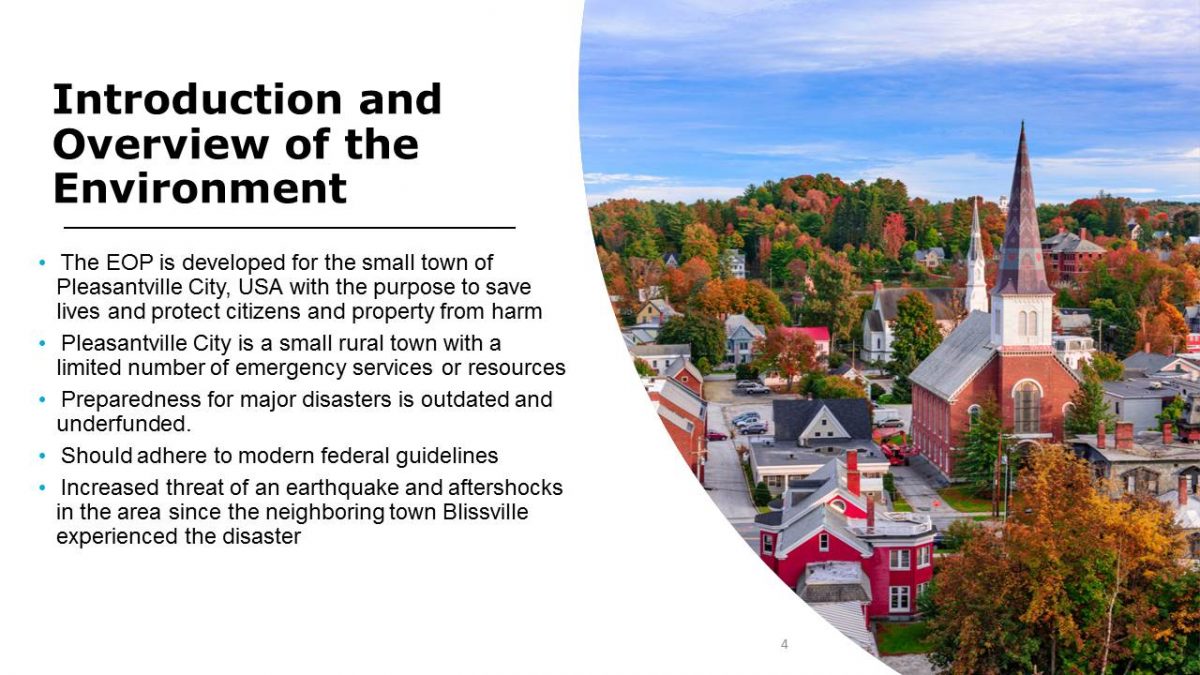
Magnitude of an Earthquake
- The shaking of the ground that occurs during an earthquake commonly inflicts significant damage to any structures in and on the ground;
- An earthquake can devastate and paralyze a city, causing multiple casualties and extensive damage to property;
- Common adverse events that occur during an earthquake:
- Collapsed and sinking buildings and structures;
- Ground displacement and landslides;
- Disrupted communications, transportation, and logistics;
- Power outages;
- Flooding due to ruptured dams and levees;
- Recurring fires due to damaged natural gas or power lines.
As evident, by the list of hazards, significant damage can occur in the city in an event of an earthquake. The extent of the hazards depends on the strength of seismic activity and other geological factors (GNS Science, n.d.).
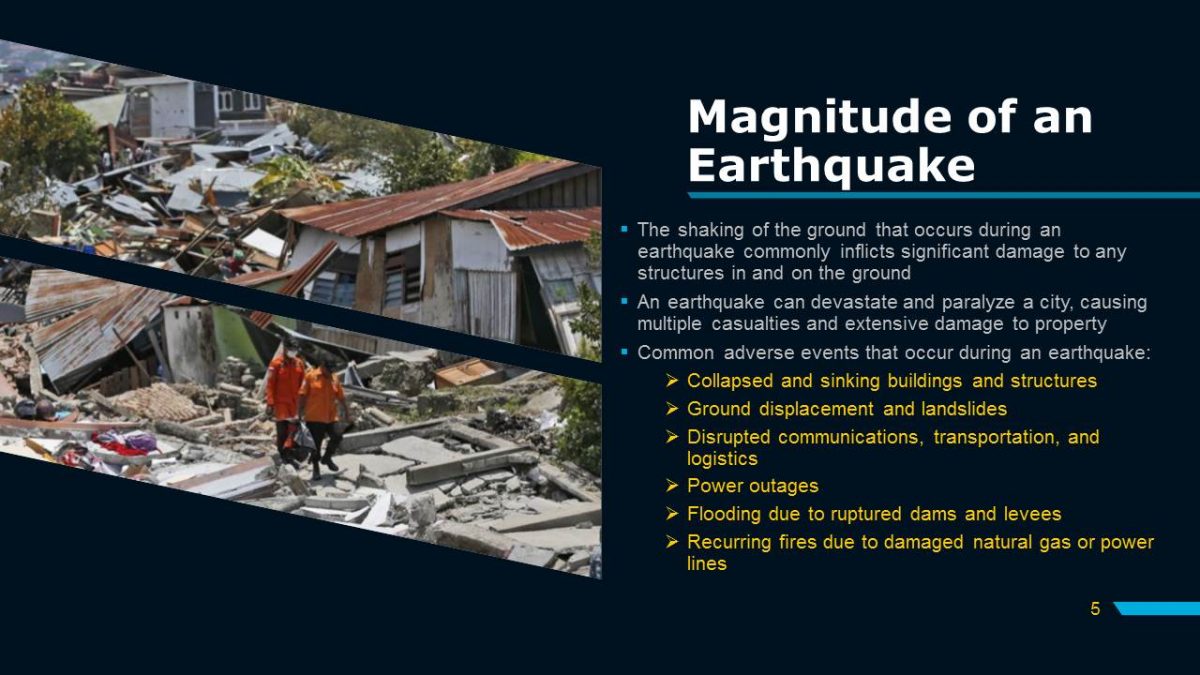
Emergency Management Elements
Mitigation
- Earthquakes are unpredictable, and mitigation measures focused on reducing hazard damage;
- Ensuring that critical city buildings are covered by insurance;
- Enacting improved and stricter building codes to ensure the structural resistance to earthquakes;
- Identifying older buildings and infrastructure (bridges) that may be exposed to damage and devising methods to improve structural integrity;
- Educating home owners and construction firms about earthquake-resistant building techniques.
Preparedness
- Training and adherence to EOP of major emergency departments and services;
- Availability and readiness of emergency supplies and equipment in predetermined inventories. Vehicles are fueled and dispersed to vital locations to be at operational readiness;
- Emergency communication channels, both interagency and to the general population should be tested;
- Schools, institutions, and organizations should have emergency plans to safeguard the population in case of emergency events.
These measures are focused on preparation and mitigation of emergency disasters, such as an earthquake focusing on having available resources to respond adequately.
Response
- Public should be alerted and provided with instructions to follow to ensure safety;
- EOP activated by the government and emergency services are notified;
- Communications are established with relevant agencies and parties;
- Begin search and rescue operations and hazard response if necessary;
- Protective measures are implemented depending on guidelines such as provided by the EPA.
Recovery
- If required, seek additional assets from neighboring states and cities;
- Conduct impact assessment and hazards after the disaster;
- Coordinate operations for recovery, search and rescue, and volunteer participation;
- Ensuring transportation, communication, and electrical power are established with all areas of the municipality;
- Operation of shelters and distribution of supplies amongst the population if necessary.
- In the long-term, rebuilding infrastructure damaged by the earthquake.
This response and recovery emergency management elements would be applicable for an EOP at the local and state levels, applicable for an earthquake disaster (Government of North Carolina, 2017).
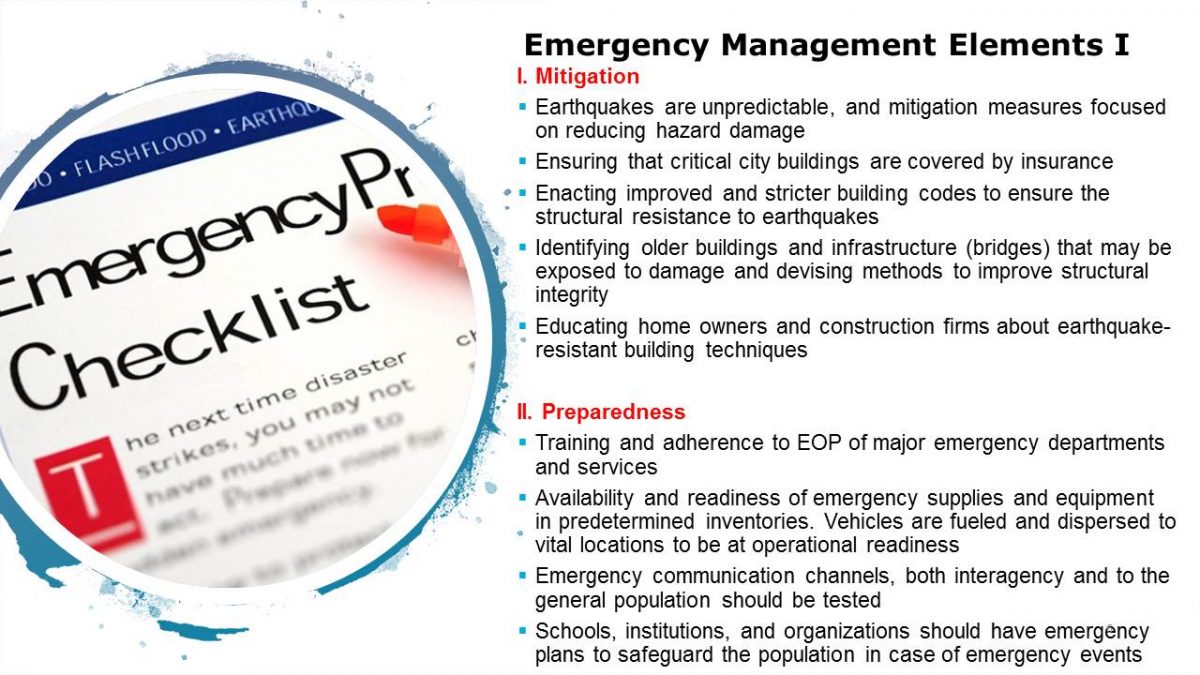
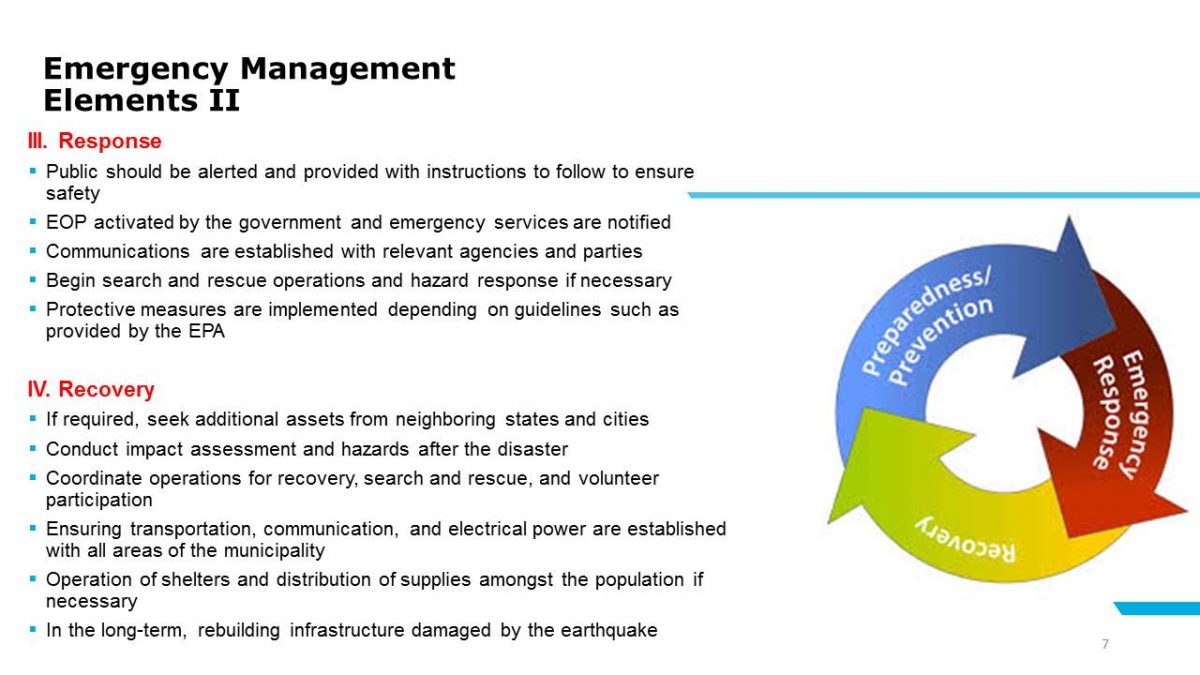
Community Plan
- Citizens are educated about techniques of staying safe during an earthquake including identifying protected locations in households and community institutions. If necessary, evacuation routes should be predetermined and followed exactly.
- Emergency response plans are available that include basic supplies and first aid.
- Caregivers and responsible parties aware of personal and medical needs of people in the household.
- Citizens should be aware how to shut-off utilities in case of damage.
- Training on the use of fire extinguishers and other safety equipment.
- Communication methods are available to receive information and seek help.
- Conduct emergency preparedness drills.
A community emergency plan is a key to community preparedness, defining preparation and local response. This helps to minimize impact and injuries, ensuring that all residents are safe.
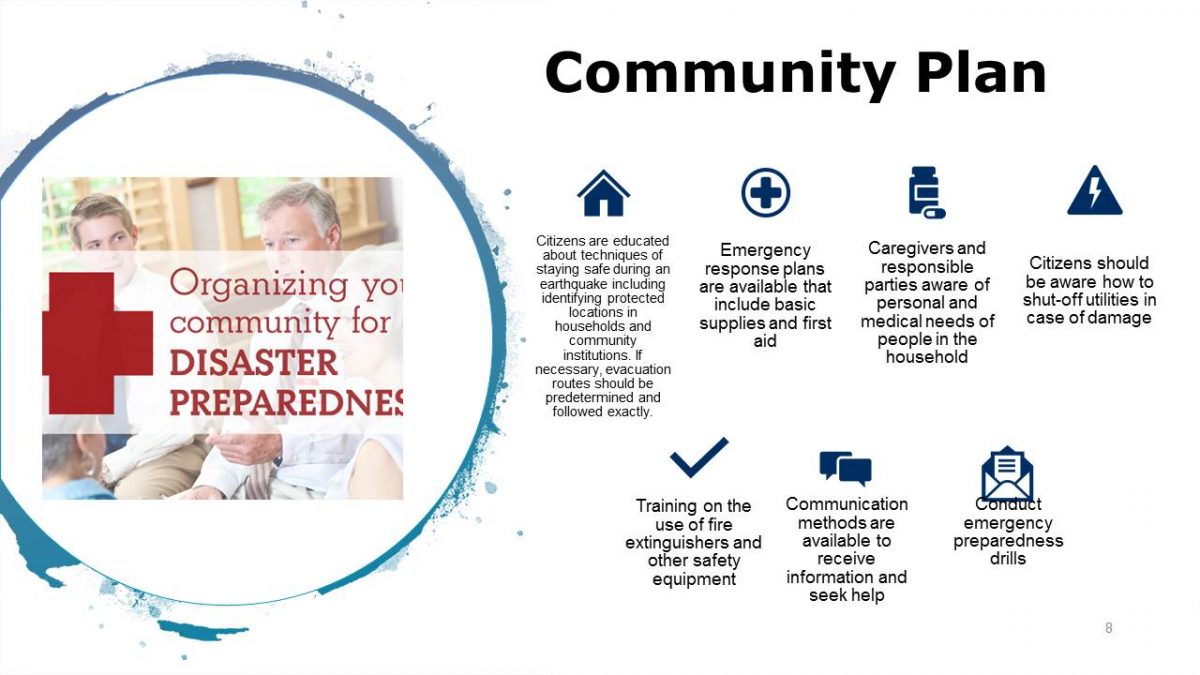
Community Resources
- Vulnerable populations in the community include children, elderly, people requiring medical care or medication, and residents without shelter.
- Communities can provide local resources for response to a disaster including:
- Trained community emergency response teams (CERT);
- Local organizations providing shelter and supplies to affected residents;
- Volunteers for non-dangerous emergency management activities.
- Community resources are effective since local proximity ensures faster response and trust amongst the population.
Community resources can be very effective at meeting response demands and protecting vulnerable populations. Local resident’s knowledge and communication are vital to ensuring that proper guidelines are followed and providing rapid access to adequate resources. Resources such as CERT teams and community shelters are usually well-organized and trained despite consisting of volunteer teams. Preparedness at the community level does not require significant financial input.
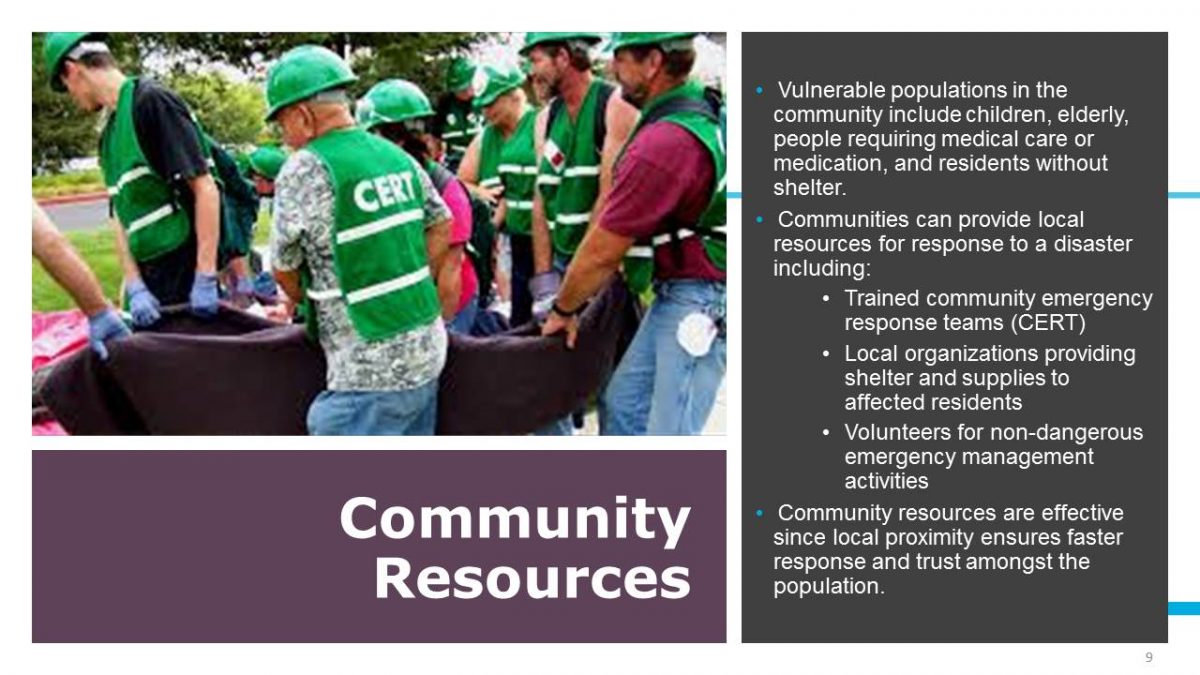
Response Plan
- Emergency Operations Plan activated in a timely manner;
- An emergency operations center or facility is established to control response and recovery efforts;
- Provide factual and timely information to the population and agencies;
- Immediately take actions to eliminate hazards within the affected area;
- Provide first aid treatment and transport of casualties to medical facilities;
- Ensure the city is receiving an adequate level of emergency services;
- Coordinated acquisition and distribution of supplies and equipment;
- Establish operations and logistics for recovery and stabilization of government services.
The response plan is a fundamental set of steps that the city must take in case of an emergency situation or disaster (City of Guelph, 2015). These are step-by-step procedures which follow standard guidelines and address vital issues. Some of the steps set a foundation for rapid first response and further recovery efforts.
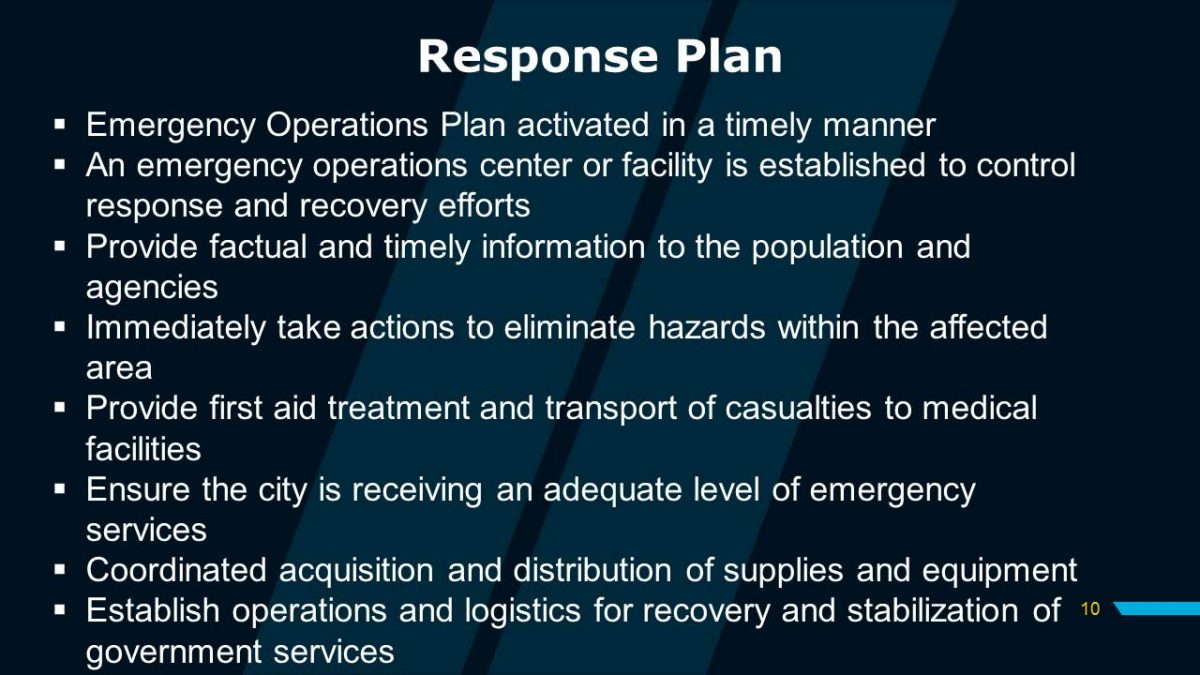
Effectiveness of Responders
- Federal responders consist of national organizations such as FEMA and the National Guard that provide funding and additional assets to areas affected by disasters.
Large-scale response operations:
- State responders and emergency management coordinates activities of several cities and communities within the state.
State responders oversee evacuation, provide financial assistance for recovery, and can declare a state of emergency.
Federal responders are extremely powerful and beneficial but may take time to arrive to the affected location. Federal responders are usually highly specialized, having experts in aspects such as engineering or nuclear power. The Federal Emergency Management Agency (FEMA) coordinates response on a broad level and provides funding for disaster management and education. They are effective in long-term recovery, but ineffective as first responders. State responders are very limited in terms of on-the-ground personnel. State response is effective in managing response and providing finances from state budget or national aid.
- Local responders include first providers of emergency services.
These include local police and fire departments as well as local hospitals. Oversees use of local resources and supplies.
- Secondary responders include organizations that aid with disaster relief and recovery.
The most well-known is the Red Cross and other similar private organizations that use resources and coordinated professionals for assistance.
Local responders are first on the scene and vital to properly responding and saving lives. Primary burden of response lies on the local emergency services. Local responders include the community response resources outlined earlier. Meanwhile, secondary responders are effective at providing long-term help during recovery, but inefficient at immediate response. However, in scenarios of budget constraints, these organizations both national and local are able to contribute significant amounts.
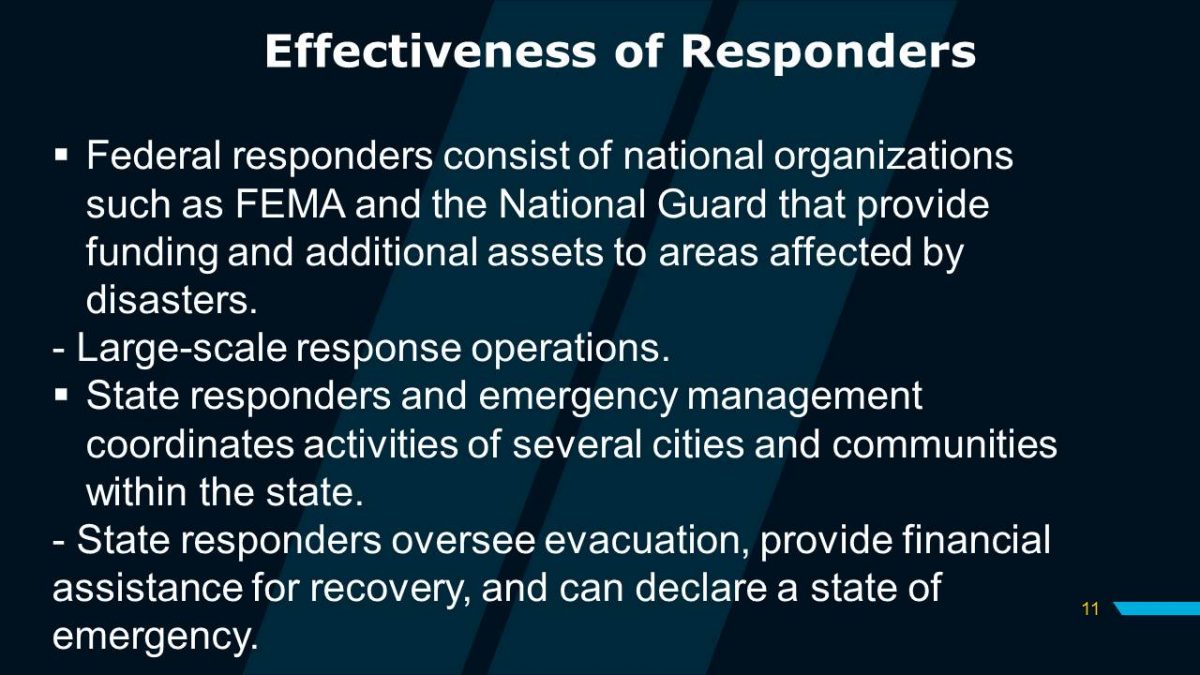
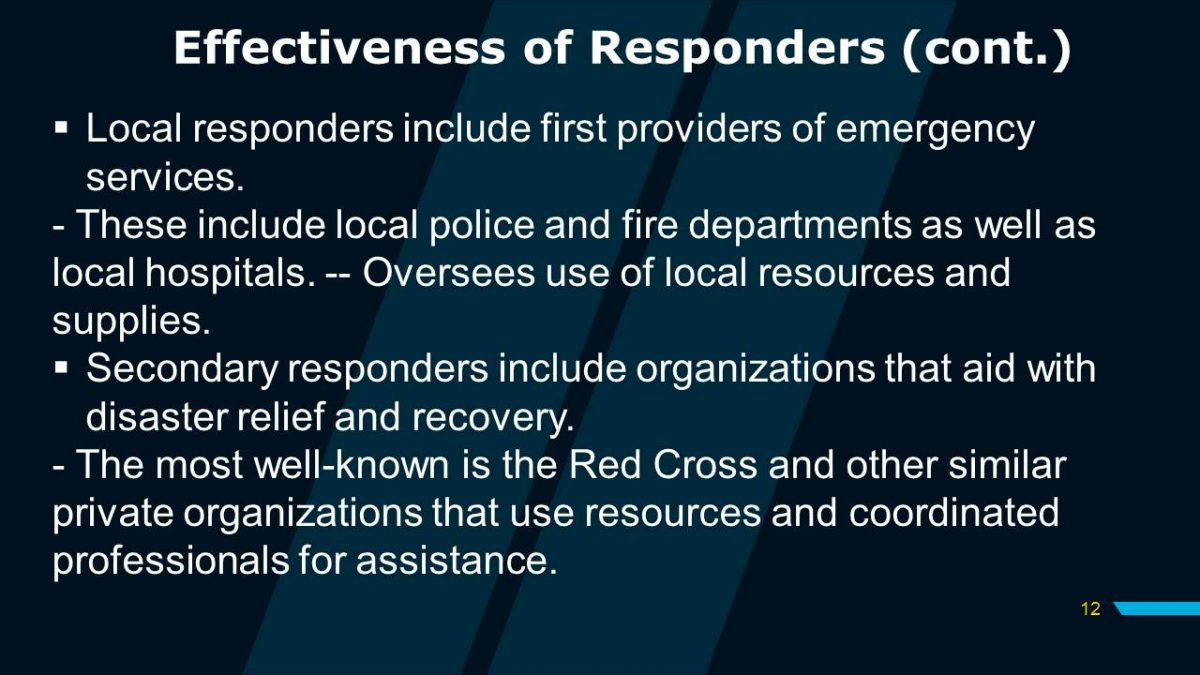
Communications Plan
- An operations center should be set-up with emergency hotlines and information broadcasted to the public via radio and television channels.
- Communication plans identifies contact information for chain of command and respective responsibilities.
- Plan specifies objectives of crisis communication while preparing or responding to an emergency.
- Emphasis on clear and factual communication.
- Provide guidelines to residents, organizations, and first responders on an action plan in case of emergency.
- Stipulates emergency procedures as part of the crisis response.
A communication plan is a vital aspect of an EOP, providing steps to establish an exchange of information amongst important parties and stakeholders in the city government. This plan is beneficial in crisis communication to account for any incidents that may occur and provide important information to determine priority issues.
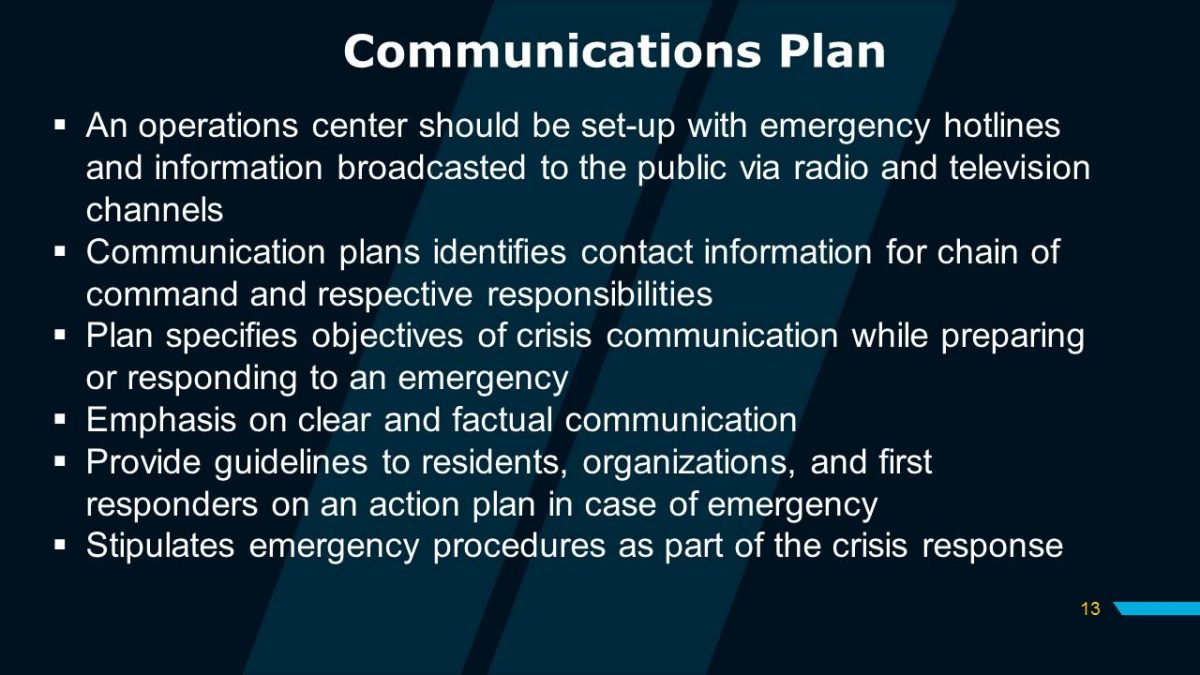
Emergency Call Lists
- City mayor and city manager are contacted;
- Heads of emergency service providers such as police chief, public safety director, public works director;
- The city’s emergency operations control group;
- Public officials coordinating disaster response;
- County and state governments are contacted;
- Communications supervisor;
- Finance director;
- Parks and Recreation Director;
- American Red Cross.
This is a list of the chain of command that is contacted in case of an emergency during the intergovernmental response. Public officials and organizations on the list are responsible for various aspects of emergency operations including first responders, public communication, and initiating the plan of action. It is vital that up-to-date information is available for each person on the list to be contacted in case of an emergency.
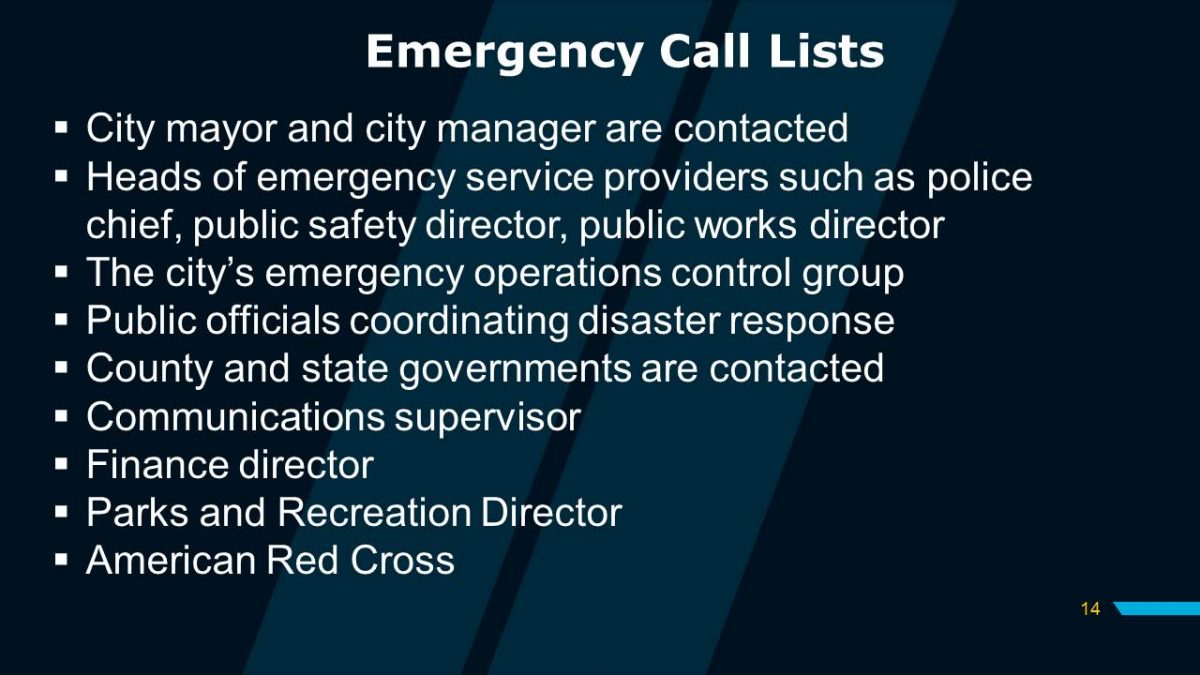
Support Documents
- Documents and records vital to continuance of government in events of disruption of normal activity;
- Direction and control functional charts;
- Emergency staffing roster;
- Emergency standard operating guidelines;
- Communications and message handling procedures;
- Significant events log;
- Warning flowchart and radio frequencies;
- Media contact information and templates for new releases;
- Damage assessment forms;
- Law, fire, and rescue functional diagrams and forms;
- Emergency procurement of supplies form;
- Public works and utility plans;
- Evacuation plans and shelter locations.
The list of support documents for an emergency operations plan is extensive because it must cover every aspect of government functionality and emergency response. Since procedures are complex and require numerous steps, these documents help to maintain track of vital information as well as provide critical data.

Resource List
Community: Trained personnel, emergency facilities, equipment.
Local: Highly trained emergency response services, modern equipment, emergency supplies, communication capacity.
State: Communications resources, state budget funding, organizational capacity.
Federal: Budget funding, logistic capacity for transport, warning system.
Secondary: Donations and funding, volunteer and professional labor, medical aid supplies.
These are some of the resources that are required by each level of responders in order to achieve their primary responsibilities and objectives during disaster response. This list is limited, and resource requirements extend further and can significantly overlap amongst the various levels of responders. Each level requires equipment for protection and containment. Critical first aid equipment such as an AED is vital. There is a necessity of proper communications and warning systems as well as facilities that can serve as shelter.
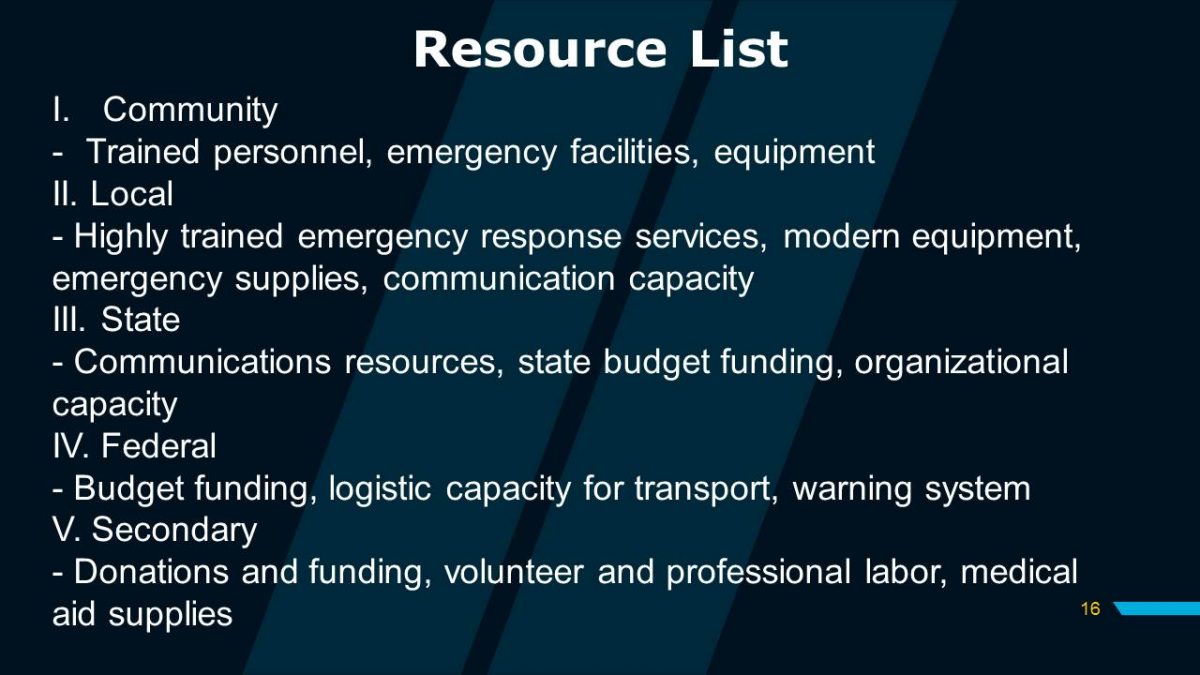
References
City of Guelph. (2015). Emergency response plan. Web.
GNS Science. (n.d.). Earthquake hazards. Web.
Government of North Carolina (2017). North Carolina emergency operations plan. Web.
Town of Groton. (n.d.) Town of Groton, Connecticut emergency operations plan and annexes. Web.